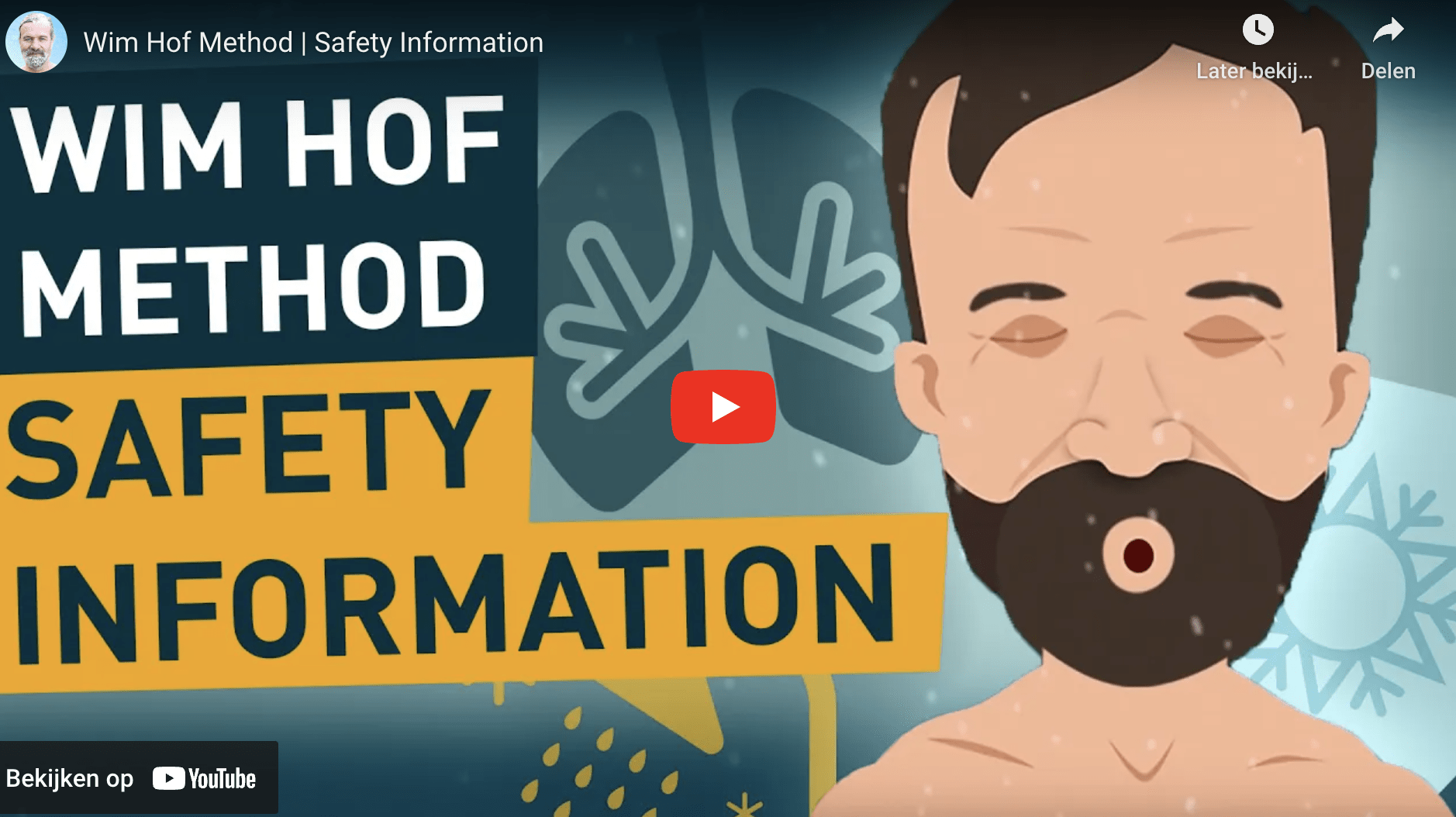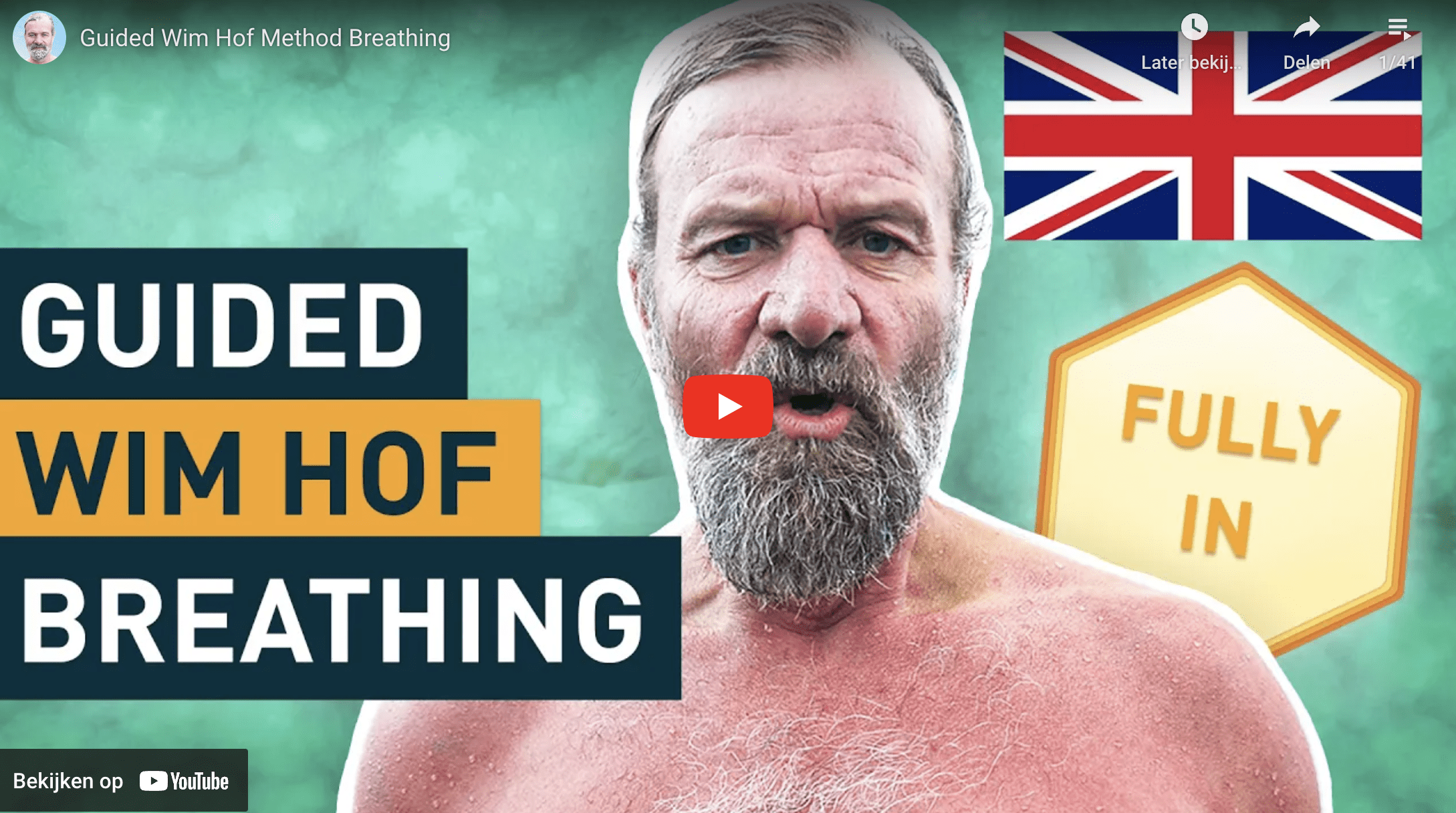What is the Wim Hof Method?
The Wim Hof Method is something simple that makes you feel relaxed and you will never get sick again. No, not really. But it does help to boost your immune system.
It's about daily breathing exercises and cold exposure, and I explain the method on this page. You can also check the official website wimhofmethod.com.

By the way, does this method cost any money?
- You don’t need to pay for a course.
- You don’t need to download the Wim Hof Method app.
- You don’t need to pay for advice.
You only need yourself.
Safety first
Before we jump to the actual method, there's this safety warning when you want to do this yourself. Because when you do these breathing exercises, you can pass out. So you should only do this when you are lying on your bed on sitting in a chair. Watch this video first.
The breathing exercises can have strong physiological effects, and must be practiced as instructed. Always perform them in a safe environment, sitting or lying down. Never practice the exercises before or during diving, driving, swimming, taking a bath, or in any other circumstance where loss of consciousness could result in bodily harm. Wim Hof breathing may cause tingling sensations, a ringing in the ears, and/or lightheadedness. These are normal responses and are no cause for alarm. If you faint, however, you have gone too far, and should take it more slowly next time.
The cold is a powerful force, and extreme cold can be a shock to your body. We strongly advise to start slow and gradually build up exposure. Always train without forcing anything, and listen to the signals from your body. If not practiced responsibly, there is risk of hypothermia.
Do not practice the method during pregnancy, or if you are epileptic. People with cardiovascular issues, or any other serious health conditions, should always consult a medical professional before starting the Wim Hof Method.

OK you got this
Learning by doing - just watch this guided breathing video and follow along. It will only cost you a couple of minutes.

Guided breathing
This is where the magic happens. Do the guided breathing with this video. This one is in English, but there are also a lot of other languages available. Soon enough you don't need this video anymore. Breathe in, breathe out. Feel.
Cold exposure
Lots of reasons to do this. This is explained in this video.

Benefits of cold exposure
- Improved Immune System: Cold exposure activates the immune system, making the body stronger and more resilient.
- Better Blood Circulation: Cold improves the efficiency of the circulatory system, which spans 70,000 miles within the body.
- Increased Energy: Enhances cardiovascular function, improving oxygen, mineral, and vitamin delivery to cells.
- Reduced Inflammation: Resets the adrenal axis, lowering inflammation—a root cause of many diseases.
- Improved Sleep: Lowers cortisol levels and enhances melatonin production for better sleep quality.
- Regulated Stress Response: Builds mental resilience and control over stress by confronting discomfort.
- Increased Willpower: Strengthens mental control and willpower, fostering greater mental resilience.
- Enhanced Mind-Body Connection: Develops interoception, the ability to connect the mind and body, aiding in mood regulation.
- Better Focus: Encourages deep concentration on bodily responses, improving overall performance.
- Hormonal Boost: Triggers a significant increase in positive hormones like adrenaline, dopamine, and serotonin for well-being.
Deep dive in the mechanics of breathing
Breathing. We do this all day long. But how does it actually works?
How normal breathing works
If you hold your breath, you might feel like you need to breathe again after about 30 seconds or so. This isn't because you're out of oxygen, but because the level of carbon dioxide in your blood gets too high. This makes you uncomfortable, and your diaphragm (a muscle below your lungs) may start twitching to make you breathe.
An explanation from nhlbi.nih.gov about what happens when you breathe:
When you breathe in, you take in oxygen from the air. This oxygen goes through tiny air sacs in your lungs called alveoli and into small blood vessels nearby, where red blood cells pick it up. They use a protein called hemoglobin to do this. At the same time, carbon dioxide, a waste gas produced by your body's cells, moves from the blood vessels back into the alveoli to be breathed out.
The blood, now full of oxygen, travels to the left side of your heart through special veins in your lungs. Your heart then pumps this oxygen-rich blood to the rest of your body, delivering oxygen to your cells. Your cells need this oxygen to create energy for your body to function. As they do this, they produce carbon dioxide as a waste product. This carbon dioxide needs to be removed from your body, so it moves from your cells back into your blood.
The carbon dioxide travels back to your heart through your bloodstream, entering the right side of your heart. From there, it's pumped to your lungs through the pulmonary artery. In the lungs, the carbon dioxide moves from the blood vessels into the alveoli, where it's exchanged for incoming oxygen. Finally, you breathe out the carbon dioxide from your lungs.
Source nhlbi.nih.gov
The composition of air
What is the composition of air when breathing in and breathing out?
Source: arily.org

Breathing in

Breathing out
What happens duringthe breathing excersise
In this step, the carbon dioxide levels in your body are intentionally reduced through deep breathing. By taking deep breaths while breathing slightly faster than usual, you help your body transition into a more relaxed state. This technique doesn't significantly increase the oxygen levels in your blood, as they are already high. Instead, it triggers relaxation by reducing carbon dioxide.
The deep diaphragmatic breathing (initiating from the stomach) stimulates the vagus nerve, a crucial part of the parasympathetic nervous system. This reduces the body's fight-or-flight response, promoting a state of calm and relaxation. These effects are key to the benefits of this breathing technique and also prepare your body for the next phase.
As you expel carbon dioxide and flood your body with oxygen, your cells are saturated with oxygen, eliminating the need for alternative methods of cellular respiration. This shifts your blood pH from the normal 7.4 to a more alkaline state, potentially reaching 7.75 or higher. The significance of this alkaline shift is that the sensors responsible for detecting acidity in your body become impaired, preventing them from activating pain-inducing receptors. As a result, you experience a reduction in pain sensitivity.
You may experience tingling sensations or light-headedness, which are common effects of lower carbon dioxide levels in the blood. Some individuals might also experience muscle cramps due to oxygen binding more tightly to their red blood cells under these conditions.
By the end of this intense breathing session, your blood is highly oxygenated and more alkaline, and you are ready to move into the second phase of the exercise.
Now, you hold your breath after breathing deeply. This lowers the oxygen level in your blood for a short time. This might sound strange, but it's actually good for your body. It triggers some positive changes, like releasing adrenaline and making adjustments to help you cope with low oxygen levels.
The purpose of this phase is to decrease the blood O2 level from ~100% to a safe but unnaturally low level for a short period of time. The body responds to this short stress in a variety of very positive ways (a valid example of hormesis) – that form the majority of the health benefits of this exercise.
Remember that in general you can hold your breath until your blood CO2 levels rise above a certain threshold? After reducing the CO2 levels in Phase #1, we can hold our breath much longer until the CO2 eventually rises that high – this can be 3-4 minutes for some people.
However your body is using up O2 throughout the retention, so after about 1 minute your blood O2 is lower than it can normally get. When the O2 level drops far enough, it triggers the body into doing a couple of cool things:
-
- After (very approximately) 90 seconds, a significant amount of adrenaline (epinephrine) is produced.
-
- The hypoxia-inducible factor 1a gene is expressed, to help the body make adjustments to better thrive in a low-O2 environment.
After holding your breath, you take a deep breath again and hold it briefly. This helps reset your body's oxygen levels. Your body uses oxygen more efficiently now, which is good for you.

How to Hold Your Breath Longer:
If you want to improve your breath-holding time, try these tips:
- Relax your body before starting.
- Get physically and mentally comfortable.
- Breathe more deeply and efficiently.
- Experiment with the pace of your breathing.
- Practice regularly to get better at it.
In the morning, on an empty stomic, does wonders too.